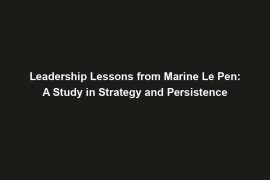Have you ever heard of Napoleon III? No, not the famous Napoleon Bonaparte, but rather his nephew who rose to power in France in the mid-19th century. While Napoleon III may not be as well-known as his uncle, his leadership style and rise to power offer valuable lessons for leaders today.
Napoleon III was a man with a grand vision for France and ambitious goals for modernization and expansion. He was able to inspire his followers and drive organizational success through his clear vision and ambitious mindset. Studying historical leaders like Napoleon III can provide us with insight into how having a vision and setting ambitious goals can lead to success in leadership.
In this blog post, we will explore three key leadership lessons from Napoleon III that are still relevant in today’s world. We will delve into the importance of vision and ambition, adaptability and flexibility, as well as communication and public relations. By learning from Napoleon III’s successes and failures, we can gain a better understanding of what it takes to be an effective leader in our modern, dynamic environment.
So, buckle up and get ready to dive into the world of Napoleon III as we uncover the leadership lessons that can help shape our own leadership styles and practices. Let’s learn from the past to lead towards a brighter future.
Lesson 1: Vision and Ambition
Let’s dive into the first leadership lesson we can learn from Napoleon III: vision and ambition. Napoleon III had big dreams for France – he wanted to modernize the country and expand its influence on the global stage. By setting ambitious goals and having a clear vision of what he wanted to achieve, Napoleon III was able to inspire his followers and drive success for his country.
Imagine you’re the captain of a ship. You can’t just aimlessly sail without a destination in mind. Similarly, as a leader, having a vision is like setting your course towards a clear goal. It gives you and your team a sense of purpose and direction, motivating everyone to work towards a common objective. Ambition, on the other hand, fuels the fire to achieve those goals. By dreaming big and aiming high, you can push yourself and your team to reach new heights.
Lesson 2: Adaptability and Flexibility
Napoleon III faced numerous obstacles and challenges during his reign, but what set him apart was his ability to adapt and overcome these hurdles. He was flexible in his approach, willing to change course when necessary, and resilient in the face of adversity. In today’s fast-paced and ever-changing world, this lesson is more relevant than ever.
Think of a tree in a storm – if it’s rigid and doesn’t bend, it’s more likely to break. But if it’s flexible and can sway with the wind, it’s more likely to weather the storm. As a leader, being adaptable and flexible means being open to change, willing to pivot when needed, and able to navigate through turbulent times. It’s about being agile and responsive, ready to pivot your strategy when circumstances demand it.
Lesson 3: Communication and Public Relations
Napoleon III was a master of communication and public relations. He knew how to use propaganda and media to shape public opinion, maintain support, and bolster his image as a leader. In today’s world of constant connectivity and information overload, the ability to communicate effectively is more important than ever.
Imagine you’re telling a story to a group of friends. How you convey your message, the words you choose, and the tone you use all play a role in how your story is perceived. As a leader, effective communication is key to building trust, credibility, and rapport with your team and stakeholders. It’s about being transparent, engaging, and authentic in your messaging, ensuring that everyone is on the same page and working towards a common goal.
Conclusion
As we wrap up our exploration of the leadership lessons from Napoleon III, it’s important to reflect on how these historical insights can be applied to our modern-day challenges. By studying the successes and failures of past leaders like Napoleon III, we can gain valuable perspectives on how to navigate the complexities of leadership in today’s world.
Recap of Key Leadership Lessons
From Napoleon III, we have learned the importance of having a clear vision and ambitious goals to inspire and drive organizational success. His adaptability and flexibility in the face of obstacles have shown us the value of resilience in leadership. Additionally, his mastery of communication and public relations highlights the significance of building trust and credibility through effective messaging.
Application to Contemporary Leadership Challenges
As we consider the leadership lessons from Napoleon III, we can apply them to our own practices in various ways. Whether it’s setting ambitious goals, adapting to change, or honing our communication skills, there are valuable insights to be gained. By incorporating these historical lessons into our leadership style, we can better address the challenges of today and inspire those around us.
Call to Action
I encourage you to reflect on your own leadership style and consider how you can incorporate the lessons we’ve discussed from Napoleon III. By learning from the past, we can better equip ourselves for the future. Let’s strive to be visionary, adaptable, and effective communicators in our own leadership roles, inspired by the history that has shaped us.
Thank you for joining me on this journey through history and leadership. I hope you feel empowered to take on your own challenges with the wisdom of the past guiding you. Here’s to embracing the lessons of Napoleon III and becoming stronger leaders in our own right!



